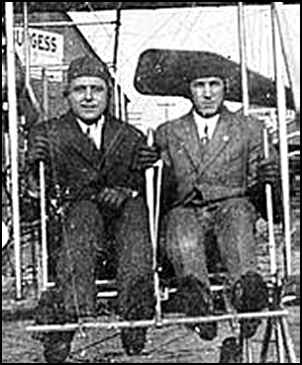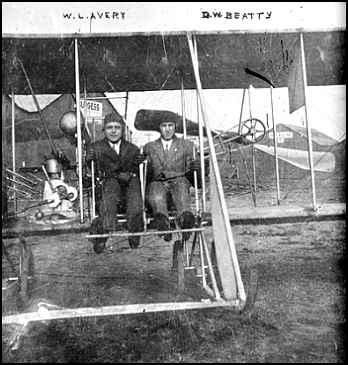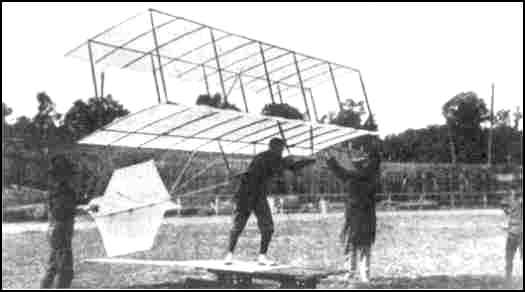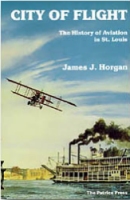
-1942 |
 |
|
Library of Congress Collection, 8-12-08 |
 |
|
Library of Congress Collection, 8-12-08 |
|
to demonstrate that progress in aerial navigation was possible... (and) to learn, through the failure and experiments of others and a comparison of notes and results, that success cannot be hoped for except through careful study and scientific investigation. Instead of returning home, most of the international aeronautic experts remained on the grounds to witness, and in some cases to participate in, the aerial events. Most were on hand when William Avery made his first trials with Chanute's glider in the stadium on October 7, using his full equipment. To launch himself into the air, the Chicago aviator mounted the glider on a small flatcar, which ran on a miniture railroad track about 100 feet long. One end of a long rope was attached to the glider and the other to a large drum, 400 feet away, which was powered by an electric motor. At Avery's signal, the drum was set in motion and rapidly took up the slack in the rope. As the flatcar gained momentum, the glider raised itself into the air, the rope was released, and the machine sailed on. Avery made three flights at the stadium on October 7. At 2:30 p.m. he took off, reached a height of 35 feet, and glided through the air for 175 feet. On his wo other efforts, altitudes of 18 to 35 feet were reached and glides of 90 to 100 feet were attained. For the next two weeks, Avery made glides almost daily in the stadium. On October 25, however, he moved his equipment to the Plaza St. Louis because he felt he needed more room to maneuver. At 3:00 p.m. October 26, he made his first trial of the biplane glider at the plaza. He reached a height of 30 feet when the rope, apparently defective, parted before his signal. The machine plunged to the ground, throwing Avery to the asphalt pavement and causing him to break his ankle. His career at the fair was ended, but he had earned a creditable record. In all, William Avery made 46 flights in Octave Chanute's glider, and he was the only man to fly a heavier-than-air machine at the exposition. |
 |
| Photocopy by Gregory M. Franzwa |
|
to fly at the St. Louis World's Fair. |
|
You will find a nice biography of William on the Wings off The Dunes website. To access the biography, just click on: William Avery You may want to use the "Find" function on "Avery." I heartily recommend that you read the whole story by clicking on: The Octave Chanute Pages |
|
William Avery, contractor, began work in 1894 constructing gliders for Octave Chanute and later glided with these same machines at Millers Station, Indiana. He soloed in 1886, in a Lilienthal type monoplane glider and in Chanute biplane and triplane and multiplane affairs. In James Means' Aeronautical Annual for 1897, O. Chanute describes these flights and says of Avery that "in the course of a week learned to manage the machine nearly as well as Mr. Herring." courtesy of Steve Remington - CollectAir |
 |
CITY OF FLIGHT: The History of Aviation in St. Louis James J. Horgan Product Details Cloth: 500 pages; 6 1/2 x 9 inches Publisher: Patrice Press, 1984 Used: $17.95 ISBN: 0-935284-35-4 |
|
Description: "From time to time, in the body of scholarly writing, there emerges a work of commanding importance. Somtimes this paper will do more than satisfy a committee; sometimes it will go beyond a noble contribution to the sum of our knowledge and will also entertain the reader. Occasionally it will be couched in plain, easy-to-understand journalism, designed to captivate a person with a sense of being there. City of Flight is all of this. James J. Horgan transports his reader into history; into the basket of the Atlantic, as the 19th century balloon crashes into the timber of upstate New York, a thousand miles after its takeoff from St. Louis. Into the Red Devil, as Thomas Scott Baldwin flies his flimsy biplane between the Mississippi River and the arches of Eads Bridge. Onto the struts of the Sky Cycle, as a 15-year-old boy pedals his little gas-filled dirigible over Forest Park. Onto Art Hill, to cheer the flyover of America's newest hero, Charlese A. Lindgergh, in his Spirit of St. Louis, in salute to the city which made it all possible. This is an epic set in the very cradle of aviation history - the City of St. Louis - now, as it was in the beginning, the City of Flight." |
|
If you have any more information on this pioneer aviator, please contact me. E-mail to Ralph Cooper |


|